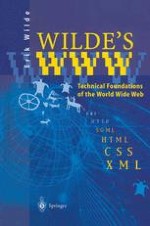What is the difference between a URL and a URI? How does HTTP fulfill its task? Why do we need XML? What is it, and will it eventually replace HTML? This book gives answers to these questions and a chore of others that may be asked by attentive inhabitants of cyberspace. The book is, of course, not just a glossary of abbreviations and frequently used terms. It is rather a comprehensive and still succinct presentation of the technology used in the World Wide Web. It is surprising to note that, even though hundreds of books have been published that discuss the Web, there have been none, so far, to thoroughly explain the inner workings of this popular Internet application, which is so simple to use and yet so complex when it comes to really understand what is going on inside. The target audience of this book is perhaps best described by how it was first used by the author himself: A draft version was chosen as the supporting text for a class of practitioners, who attended a continuing education course on WWW technology. These were people who knew what the Web is, and how it may be used for business, but needed to know how the technology works. During the planning for this course, the author found that no suitable book was on the market, and decided to write one himself.
